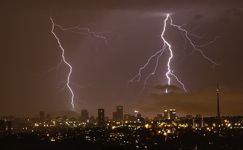Wits unit aims to demystify lightning
9 January 2014
About 500 people are killed by lightning strikes every year in South Africa - and
scientists at the University of the Witwatersrand (Wits) in Johannesburg are
determined to lower that number.
The lightning research team, which the university formed in mid-1960s, are "really
pushing the boundaries of what is known about lightning deaths and injuries", National
Geographic says on its website.
"South Africa has known about the risks of lightning since 1973, when we introduced a
'risk analysis process' that stated exactly how dangerous lightning could be," said
engineer Andrew Dickson. "But we are still somehow accepting around 500 deaths a
year."
The group of electrical engineers, anthropologists and biomedical experts are
conducting experiments to understand how the human body reacts to a lightning
strike, the website reports.
Their findings could help doctors treat victims more effectively and improve
education
about lightning safety, helping to prevent casualties and even deaths.
"This work has potential to give scientists a way to look at the complex human body
in a very different way," Patrick Randolph-Quinney, a forensic anthropologist at Wits,
is quoted as saying. He hopes emerging research will help doctors better treat
lightning injuries and assist forensics investigators in pinpointing the cause of death
from a lightning strike.
People in the rural areas of South Africa are particularly vulnerable as they work
outdoors and the poor infrastructure provides minimal protection. There is also a lack
of education about the dangers of lightning, the magazine says.
Other work being done at the university highlighted by the magazine includes:
- Injuries: electrical engineering graduate student Harry Lee is comparing the
electrical conductivity of 56 different human tissues to find out why some parts of the
body are damaged more
than others.
- Education: the group at Wits is compiling lightning safety rules to help educate
the public. Two engineering students have created a computer game aimed at primary
school pupils on how to be safe when there is a thunderstorm.
"We don't live in America," Ken Nixon, a Wits university electrical engineer said. "[The
popular rule] 'when thunder roars, go indoors' isn't going to work because for many,
indoors isn't a sturdy building. So the way we approach these education tactics is
going to be fundamentally different."
SAinfo reporter and National
Geographic
 Lightning over Johannesburg. (Photo: Derek Keats/Flickr)
Lightning over Johannesburg. (Photo: Derek Keats/Flickr)



